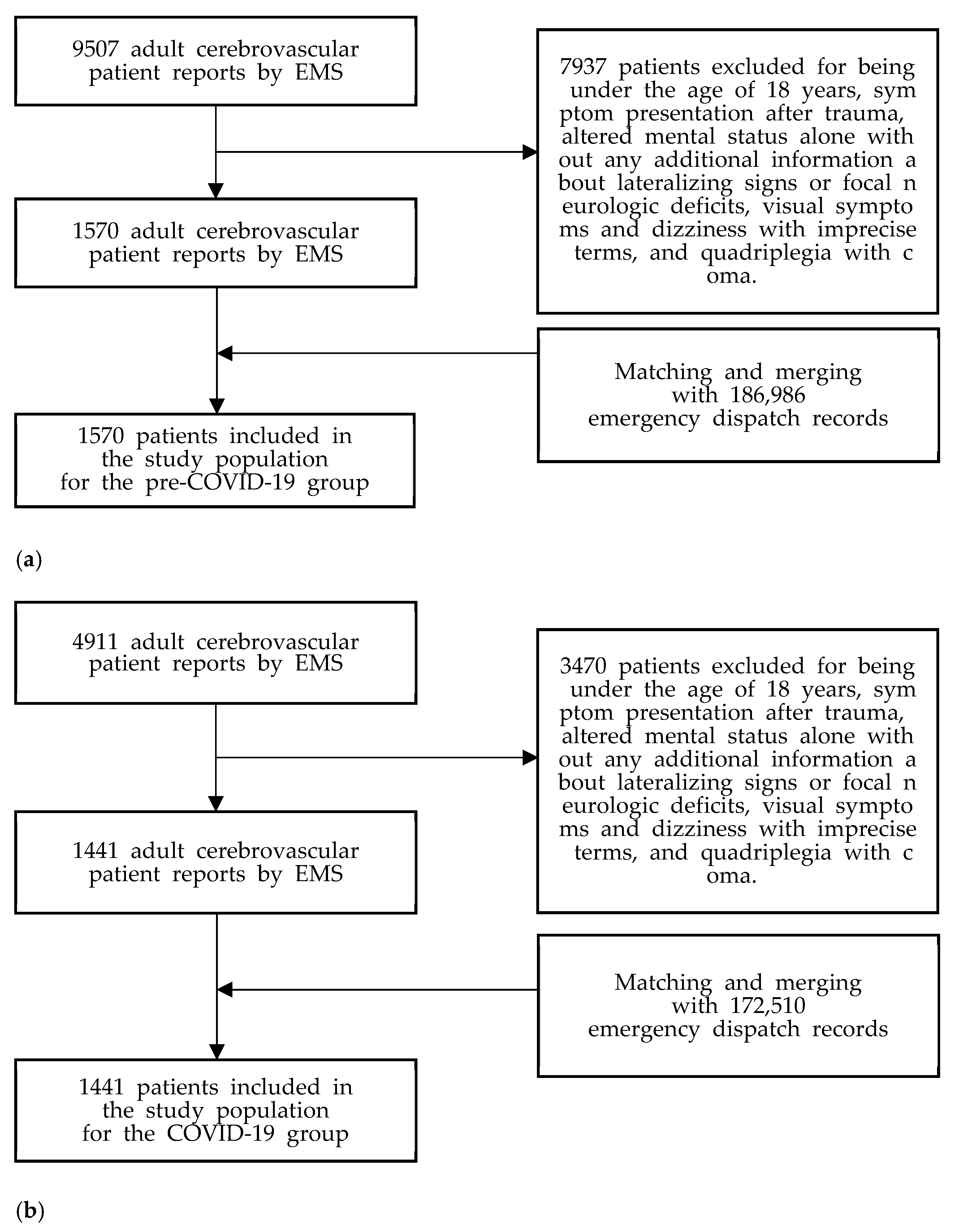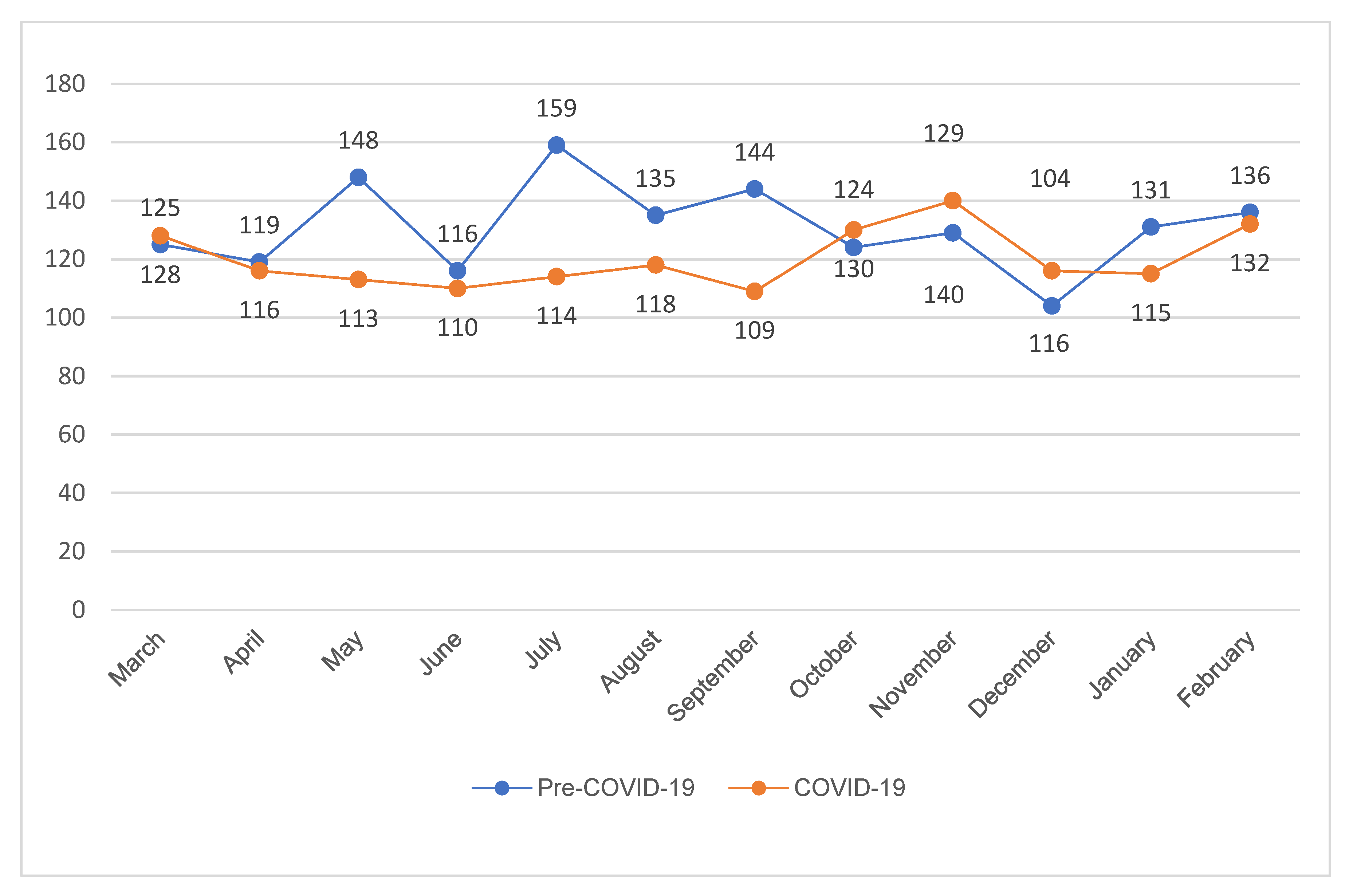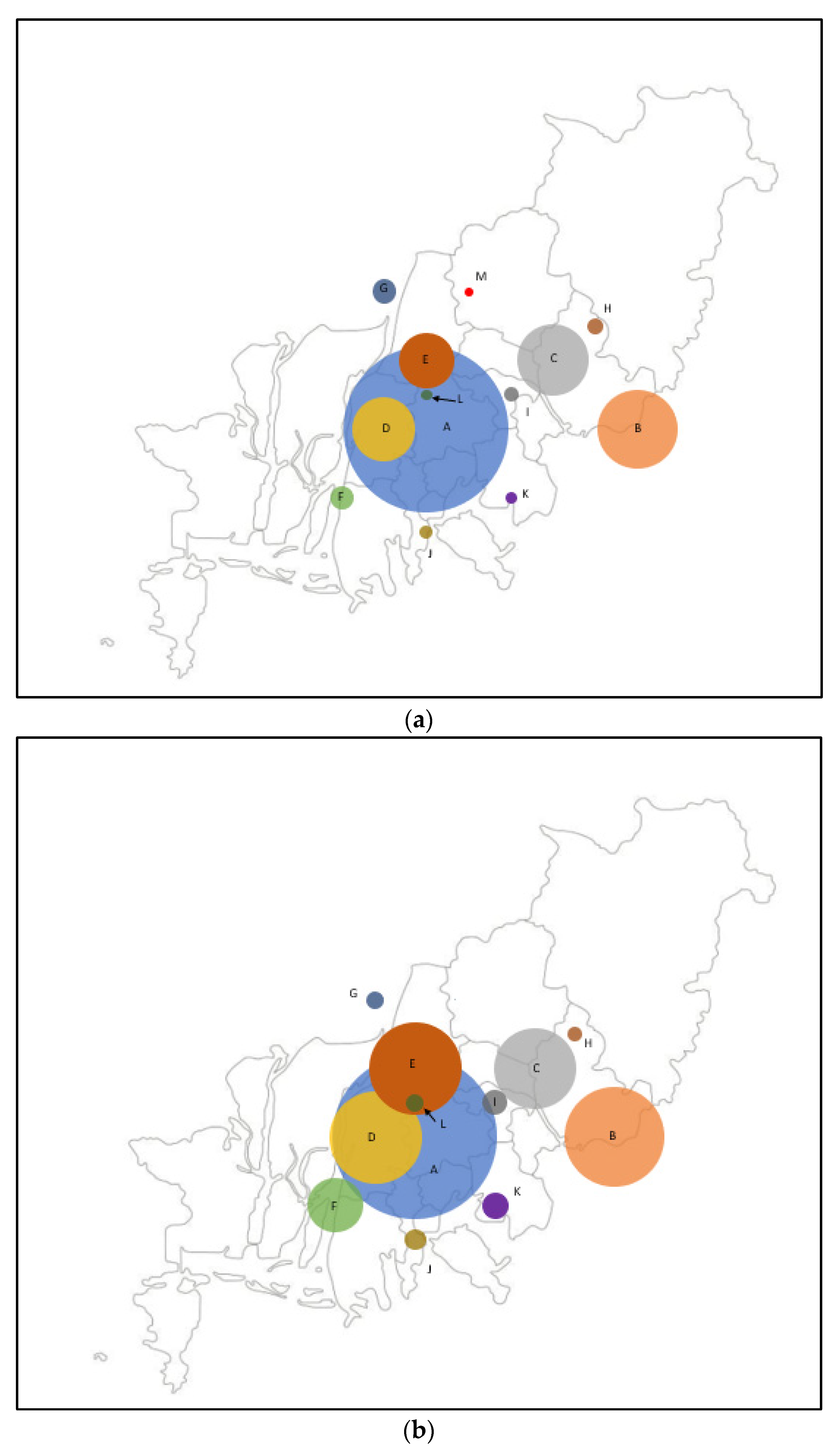Impact of COVID-19 on Emergency Medical Services for Patients with Acute Stroke Presentation in Busan, South Korea
Abstract
:1. Introduction
2. Materials and Methods
2.1. Study Design
2.2. Study Setting
2.3. Data Sources and Collection
2.4. Outcome Measures
2.5. Statistical Analysis
3. Results
3.1. Comparison of EMS Processing Time for Patients with Acute Stroke Symptoms before and during COVID-19
3.2. Comparison of the Number of Patients with Acute Stroke Symptoms Using EMS Who Were Transferred to EDs before and during COVID-19
4. Discussion
Author Contributions
Funding
Institutional Review Board Statement
Informed Consent Statement
Data Availability Statement
Conflicts of Interest
References
- Saver, J.L.; Smith, E.E.; Fonarow, G.C.; Reeves, M.J.; Zhao, X.; Olson, D.M.; Schwamm, L.H.; Committee, G.W.-S.S.; Investigators. The “golden hour” and acute brain ischemia: Presenting features and lytic therapy in >30,000 patients arriving within 60 minutes of stroke onset. Stroke 2010, 41, 1431–1439. [Google Scholar] [CrossRef] [Green Version]
- Adams, H.P.; del Zoppo, G.; Alberts, M.J.; Bhatt, D.L.; Brass, L.; Furlan, A.; Grubb, R.L.; Higashida, R.T.; Jauch, E.C.; Kidwell, C.; et al. Guidelines for the early management of adults with ischemic stroke: A guideline from the American Heart Association/American Stroke Association Stroke Council, Clinical Cardiology Council, Cardiovascular Radiology and Intervention Council, and the Atherosclerotic Peripheral Vascular Disease and Quality of Care Outcomes in Research Interdisciplinary Working Groups: The American Academy of Neurology affirms the value of this guideline as an educational tool for neurologists. Stroke 2007, 38, 1655–1711. [Google Scholar] [PubMed] [Green Version]
- Lacy, C.R.; Suh, D.-C.; Bueno, M.; Kostis, J.B. Delay in presentation and evaluation for acute stroke: Stroke time registry for outcomes knowledge and epidemiology (STROKE). Stroke 2001, 32, 63–69. [Google Scholar] [CrossRef] [PubMed] [Green Version]
- Kothari, R.; Jauch, E.; Broderick, J.; Brott, T.; Sauerbeck, L.; Khoury, J.; Liu, T. Acute stroke: Delays to presentation and emergency department evaluation. Ann. Emerg. Med. 1999, 33, 3–8. [Google Scholar] [CrossRef]
- Rosamond, W.D.; Gorton, R.A.; Hinn, A.R.; Hohenhaus, S.M.; Morris, D.L. Rapid response to stroke symptoms: The delay in accessing stroke healthcare (DASH) study. Acad. Emerg. Med. 1998, 5, 45–51. [Google Scholar] [CrossRef]
- Abdullah, A.R.; Smith, E.E.; Biddinger, P.D.; Kalenderian, D.; Schwamm, L.H. Advance hospital notification by EMS in acute stroke is associated with shorter door-to-computed tomography time andincreased likelihood of administration of tissue-plasminogen activator. Prehosp. Emerg. Care 2008, 12, 426–431. [Google Scholar] [CrossRef] [PubMed]
- Morris, D.L.; Rosamond, W.; Madden, K.; Schultz, C.; Hamilton, S. Prehospital and emergency department delays after acute stroke. Stroke 2000, 31, 2585–2590. [Google Scholar] [CrossRef]
- Xian, Y.; Holloway, R.G.; Chan, P.S.; Noyes, K.; Shah, M.N.; Ting, H.H.; Chappel, A.R.; Peterson, E.D.; Friedman, B. Association between stroke center hospitalization for acute ischemic stroke and mortality. JAMA 2011, 305, 373–380. [Google Scholar] [CrossRef]
- Marijon, E.; Karam, N.; Jost, D.; Perrot, D.; Frattini, B.; Derkenne, C.; Sharifzadehgan, A.; Waldmann, V.; Beganton, F.; Narayanan, K.; et al. Out-of-hospital cardiac arrest during the COVID-19 pandemic in Paris, France: A population-based, observational study. Lancet Public Health 2020, 5, e437–e443. [Google Scholar] [CrossRef]
- Kwok, C.S.; Gale, C.P.; Kinnaird, T.; Curzen, N.; Ludman, P.; Kontopantelis, E.; Wu, J.; Denwood, T.; Fazal, N.; Deanfield, J.; et al. Impact of COVID-19 on percutaneous coronary intervention for ST-elevation myocardial infarction. Heart 2020, 106, 1805–1811. [Google Scholar] [CrossRef]
- Meza, H.T.; Gil, Á.L.; Saldaña, A.S.; Martínez-Zabaleta, M.; Juez, P.d.l.R.; Martínez, E.L.-C.; Apilánez, M.C.; Isasi, M.H.; Enguita, J.M.; Alfonso, M.d.L.; et al. Impact of COVID-19 outbreak on ischemic stroke admissions and in-hospital mortality in North-West Spain. Int. J. Stroke 2020, 15, 755–762. [Google Scholar] [CrossRef] [PubMed]
- Rudilosso, S.; Laredo, C.; Vera, V.; Vargas, M.; Renú, A.; Llull, L.; Obach, V.; Amaro, S.; Urra, X.; Torres, F.; et al. Acute stroke care is at risk in the era of COVID-19: Experience at a comprehensive stroke center in Barcelona. Stroke 2020, 51, 1991–1995. [Google Scholar] [CrossRef] [PubMed]
- Montaner, J.; Barragán-Prieto, A.; Pérez-Sánchez, S.; Escudero-Martínez, I.; Moniche, F.; Sánchez-Miura, J.A.; Ruiz-Bayo, L.; González, A. Break in the stroke chain of survival due to COVID-19. Stroke 2020, 51, 2307–2314. [Google Scholar] [CrossRef] [PubMed]
- Statistics Korea. Available online: https://kosis.kr/covid_eng/covid_index.do (accessed on 1 December 2021).
- Lim, D.; Park, S.Y.; Choi, B.; Kim, S.H.; Ryu, J.H.; Kim, Y.H.; Sung, A.J.; Bae, B.K.; Kim, H.B. The comparison of emergency medical service responses to and outcomes of out-of-hospital cardiac arrest before and during the COVID-19 pandemic in an area of Korea. J. Korean Med. Sci. 2021, 36, e255. [Google Scholar] [CrossRef] [PubMed]
- Statistics Korea. Available online: https://sgis.kostat.go.kr/jsp/english/index.jsp (accessed on 1 December 2021).
- Edelson, D.P.; Sasson, C.; Chan, P.S.; Atkins, D.L.; Aziz, K.; Becker, L.B.; Berg, R.A.; Bradley, S.M.; Brooks, S.C.; Cheng, A.; et al. Interim guidance for basic and advanced life support in adults, children, and neonates with suspected or confirmed COVID-19: From the emergency cardiovascular care committee and get with the guidelines-resuscitation adult and pediatric task forces of the American Heart Association. Circulation 2020, 141, e933–e943. [Google Scholar]
- Alberts, M.J.; Latchaw, R.E.; Selman, W.R.; Shephard, T.; Hadley, M.N.; Brass, L.M.; Koroshetz, W.; Marler, J.R.; Booss, J.; Zorowitz, R.D.; et al. Recommendations for comprehensive stroke centers: A consensus statement from the Brain Attack Coalition. Stroke 2005, 36, 1597–1616. [Google Scholar] [CrossRef]
- Siegler, J.E.; Zha, A.M.; Czap, A.L.; Ortega-Gutierrez, S.; Farooqui, M.; Liebeskind, D.S.; Desai, S.M.; Hassan, A.E.; Starosciak, A.K.; Linfante, I.; et al. Influence of the COVID-19 pandemic on treatment times for acute ischemic stroke: The society of vascular and interventional neurology multicenter collaboration. Stroke 2021, 52, 40–47. [Google Scholar] [CrossRef]
- Ikenberg, B.; Hemmer, B.; Dommasch, M.; Kanz, K.-G.; Wunderlich, S.; Knier, B. Code stroke patient referral by emergency medical services during the public COVID-19 pandemic lockdown. J. Stroke Cerebrovasc. Dis. 2020, 29, 105175. [Google Scholar] [CrossRef]
- Bullrich, M.B.; Fridman, S.; Mandzia, J.L.; Mai, L.M.; Khaw, A.; Vargas Gonzalez, J.C.; Bagur, R.; Sposato, L.A. COVID-19: Stroke admissions, emergency department visits, and prevention clinic referrals. Can. J. Neurol. Sci. 2020, 47, 693–696. [Google Scholar] [CrossRef]
- Uchino, K.; Kolikonda, M.K.; Brown, D.; Kovi, S.; Collins, D.; Khawaja, Z.; Buletko, A.B.; Russman, A.N.; Hussain, M.S. Decline in stroke presentations during COVID-19 surge. Stroke 2020, 51, 2544–2547. [Google Scholar] [CrossRef]
- Satty, T.; Ramgopal, S.; Elmer, J.; Mosesso, V.N.; Martin-Gill, C. EMS responses and non-transports during the COVID-19 pandemic. Am. J. Emerg. Med. 2021, 42, 1–8. [Google Scholar] [CrossRef]
- Schirmer, C.M.; Ringer, A.J.; Arthur, A.S.; Binning, M.J.; Fox, W.C.; James, R.F.; Levitt, M.R.; Tawk, R.G.; Veznedaroglu, E.; Walker, M.; et al. Delayed presentation of acute ischemic strokes during the COVID-19 crisis. J. Neurointerv. Surg. 2020, 12, 639–642. [Google Scholar] [CrossRef]
- Teo, K.-C.; Leung, W.C.Y.; Wong, Y.-K.; Liu, R.K.C.; Chan, A.H.Y.; Choi, O.M.Y.; Kwok, W.-M.; Leung, K.-K.; Tse, M.-Y.; Cheung, R.T.F.; et al. Delays in stroke onset to hospital arrival time during COVID-19. Stroke 2020, 51, 2228–2231. [Google Scholar] [CrossRef]
- Kim, Y.D.; Nam, H.S.; Sohn, S.I.; Park, H.; Hong, J.H.; Kim, G.S.; Seo, K.D.; Yoo, J.; Baek, J.H.; Seo, J.H.; et al. Care process of recanalization therapy for acute stroke during the COVID-19 outbreak in South Korea. J. Clin. Neurol. 2021, 17, 63–69. [Google Scholar] [CrossRef]
- Ramos-Pachón, A.; García-Tornel, Á.; Millán, M.; Ribó, M.; Amaro, S.; Cardona, P.; Martí-Fàbregas, J.; Roquer, J.; Silva, Y.; Ustrell, X.; et al. Bottlenecks in the acute stroke care system during the COVID-19 pandemic in Catalonia. Cerebrovasc. Dis. 2021, 50, 551–559. [Google Scholar] [CrossRef]
- Bersano, A.; Kraemer, M.; Touzé, E.; Weber, R.; Alamowitch, S.; Sibon, I.; Pantoni, L. Stroke care during the COVID-19 pandemic: Experience from three large European countries. Eur. J. Neurol. 2020, 27, 1794–1800. [Google Scholar] [CrossRef]
- Kim, S.J.; Kim, H.; Park, Y.H.; Kang, C.Y.; Ro, Y.S.; Kim, O.H. Analysis of the impact of the coronavirus disease epidemic on the emergency medical system in South Korea using the Korean triage and acuity scale. Yonsei Med. J. 2021, 62, 631–639. [Google Scholar] [CrossRef]
- Dinh, M.M.; Russell, S.B. Overcrowding kills: How COVID-19 could reshape emergency department patient flow in the new normal. Emerg. Med. Australas. 2021, 33, 175–177. [Google Scholar] [CrossRef]
- Barbieri, A.; Melegari, G.; Lob, V.; Mazzali, L.; D’Amelio, L.; Giovannoni, A.; Giuliani, E. Response by twin Italian hub hospitals in a double seismic event: A retrospective observational investigation. Prehosp. Emerg. Care 2018, 22, 353–360. [Google Scholar] [CrossRef] [PubMed] [Green Version]
- Meretoja, A.; Roine, R.O.; Kaste, M.; Linna, M.; Roine, S.; Juntunen, M.; Erilä, T.; Hillbom, M.; Marttila, R.; Rissanen, A.; et al. Effectiveness of primary and comprehensive stroke centers: PERFECT stroke: A nationwide observational study from Finland. Stroke 2010, 41, 1102–1107. [Google Scholar] [CrossRef] [PubMed]



| Variables | Study Period | Mean (min) | Q1 (min) | Median (min) | Q3 (min) | p Value |
|---|---|---|---|---|---|---|
| EMS processing time | pre-COVID-19 | 31.3 | 23.0 | 29.0 | 37.0 | <0.001 |
| COVID-19 | 35.4 | 25.0 | 33.0 | 41.0 | ||
| Call time | pre-COVID-19 | 2.2 | 2.0 | 2.0 | 3.0 | 0.061 |
| COVID-19 | 2.3 | 2.0 | 2.0 | 3.0 | ||
| Response time | pre-COVID-19 | 6.8 | 4.0 | 6.0 | 8.0 | <0.001 |
| COVID-19 | 7.7 | 5.0 | 7.0 | 9.0 | ||
| Scene time | pre-COVID-19 | 8.0 | 5.0 | 7.0 | 10.0 | <0.001 |
| COVID-19 | 10.4 | 6.0 | 9.0 | 13.0 | ||
| Transport time | pre-COVID-19 | 14.3 | 8.0 | 13.0 | 19.0 | 0.034 |
| COVID-19 | 15.0 | 8.0 | 12.0 | 19.0 |
| ED | Pre-COVID-19 | COVID-19 | Changes | p Value | |||
|---|---|---|---|---|---|---|---|
| A | 436 | (28.15) | 311 | (21.78) | ▼125 | (▼6.37) | <0.001 |
| B | 211 | (13.62) | 189 | (13.24) | ▼22 | (▼0.39) | 0.799 |
| C | 190 | (12.27) | 154 | (10.78) | ▼36 | (▼1.48) | 0.228 |
| D | 167 | (10.78) | 175 | (12.25) | ▲8 | (▲1.47) | 0.229 |
| E | 148 | (9.55) | 176 | (12.32) | ▲28 | (▲2.77) | 0.018 |
| F | 63 | (4.07) | 104 | (7.28) | ▲41 | (▲3.22) | <0.001 |
| G | 63 | (4.07) | 35 | (2.45) | ▼28 | (▼1.62) | 0.018 |
| H | 41 | (2.65) | 28 | (1.96) | ▼13 | (▼0.69) | 0.262 |
| I | 39 | (2.52) | 47 | (3.29) | ▲8 | (▲0.77) | 0.250 |
| J | 34 | (2.19) | 40 | (2.80) | ▲6 | (▲0.61) | 0.345 |
| K | 30 | (1.94) | 50 | (3.50) | ▲20 | (▲1.56) | 0.012 |
| L | 29 | (1.87) | 33 | (2.31) | ▲4 | (▲0.44) | 0.478 |
| M | 23 | (1.48) | 3 | (0.21) | ▼20 | (▼1.27) | <0.001 |
| Total | 1570 | (100%) | 1441 | (100%) | 0.077 | ||
Publisher’s Note: MDPI stays neutral with regard to jurisdictional claims in published maps and institutional affiliations. |
© 2021 by the authors. Licensee MDPI, Basel, Switzerland. This article is an open access article distributed under the terms and conditions of the Creative Commons Attribution (CC BY) license (https://creativecommons.org/licenses/by/4.0/).
Share and Cite
Kim, J.; Kim, C.; Park, S.Y. Impact of COVID-19 on Emergency Medical Services for Patients with Acute Stroke Presentation in Busan, South Korea. J. Clin. Med. 2022, 11, 94. https://doi.org/10.3390/jcm11010094
Kim J, Kim C, Park SY. Impact of COVID-19 on Emergency Medical Services for Patients with Acute Stroke Presentation in Busan, South Korea. Journal of Clinical Medicine. 2022; 11(1):94. https://doi.org/10.3390/jcm11010094
Chicago/Turabian StyleKim, Jiyoung, Choongrak Kim, and Song Yi Park. 2022. "Impact of COVID-19 on Emergency Medical Services for Patients with Acute Stroke Presentation in Busan, South Korea" Journal of Clinical Medicine 11, no. 1: 94. https://doi.org/10.3390/jcm11010094
APA StyleKim, J., Kim, C., & Park, S. Y. (2022). Impact of COVID-19 on Emergency Medical Services for Patients with Acute Stroke Presentation in Busan, South Korea. Journal of Clinical Medicine, 11(1), 94. https://doi.org/10.3390/jcm11010094






